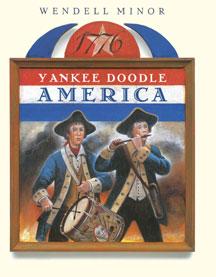Full Text Reviews: School Library Journal - 04/01/2006 Gr 3-6-In colonial America, the public houses served as the news hubs of their surrounding areas, places where people could gather to share talk of the day, whether it was national or local politics. Using hand-carved replicas of the signs for these inns and taverns to share facts about the American Revolution, Minor, in concert with master woodworker John Reichling, has created an unusual alphabet book. Covering aspects of the Revolution from the Stamp Act to the Old North Church to the X Regiment and Elizabeth Zane, this visually arresting treatment acts as an engrossing introduction to some of the people, places, and events that figured in America's fight for independence. Minor has filled the centers of two distinctive sign-board shapes with beautiful, deep-hued oil paintings. The letter addressed on each page is on the top of the board, with the full title (e.g., "Native American: The Mohawk Chief") incorporated into the image. The result is startling, and the shadow cast by the sign gives each picture a sense of depth. The factual material is correct, clearly stated, and intriguing, leading students on to more detailed treatments of the American Revolution. Pair this book with Stuart Murray's American Revolution (DK, 2002) or Lynda Graham-Barber's Doodle Dandy! The Complete Book of Independence Day Words (S & S, 1992), for a riveting visual introduction to the Revolutionary War.-Ann Welton, Grant Elementary School, Tacoma, WA Copyright 2006 Reed Business Information. - Copyright 2006 Publishers Weekly, Library Journal and/or School Library Journal used with permission. Booklist - 04/15/2006 Gr. 1–3. As the subtitle implies, this alphabet book introduces aspects of America during the Revolutionary War period. A typical entry includes a paragraph or two of text and an illustration. Using the alphabet as an organizing device for presenting information yields scattershot results here. Molly Pitcher and Henry Knox get the same attention as George Washington and Thomas Jefferson, and some statements are overly broad. For example, the explanation accompanying Q is for Quakers, which reads Quakers were prosperous farmers who believed in religious freedom . . . , is problematic, as it excludes Quaker merchants and lawyers as well as Quaker farmers who did not prosper. The most distinctive, memorable aspect of the book is the exceptionally fine artwork. Each letter of the alphabet is illustrated with a painting on a wooden panel that has been shaped to resemble the sign on a colonial inn. The pictures, evidently inspired by period portraits, prints, paintings, and flags, feature warm colors and fine compositions, enhanced by a crackle-glazed finish. - Copyright 2006 Booklist. Loading...
|



